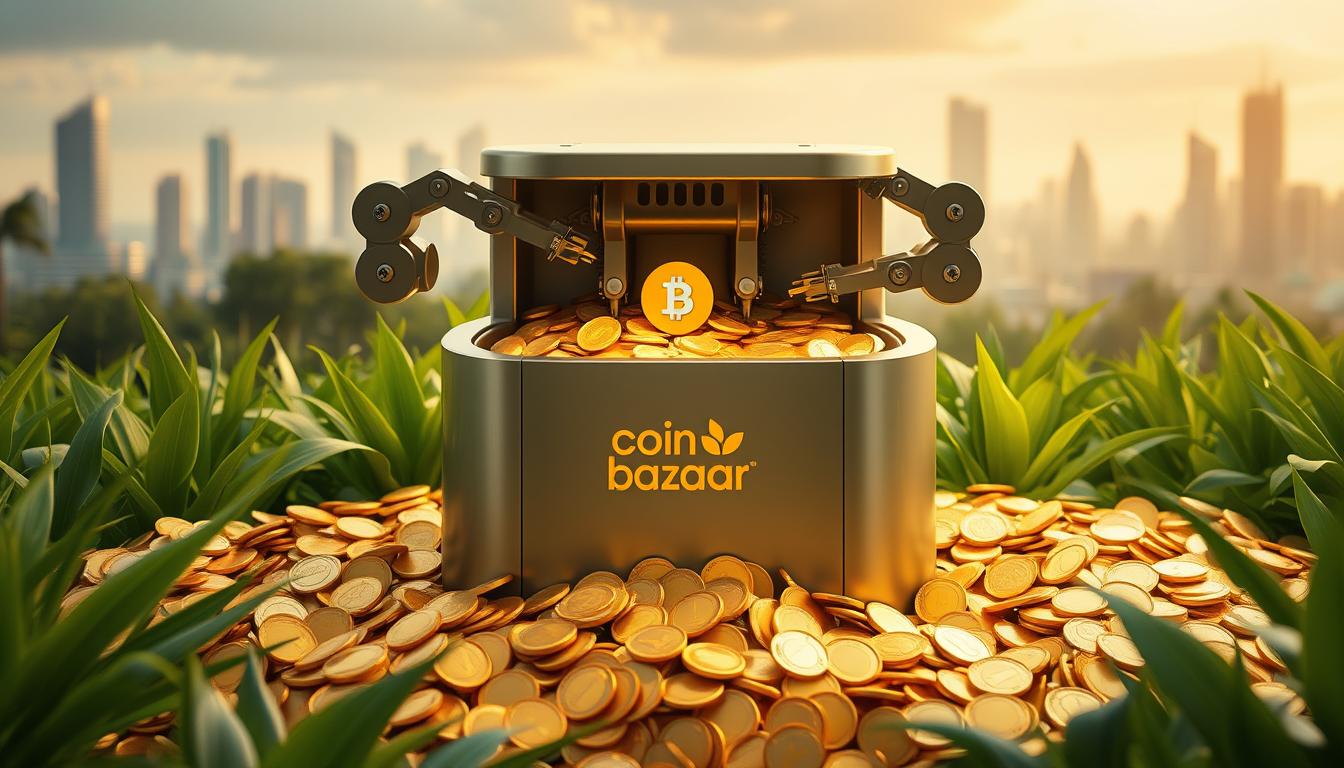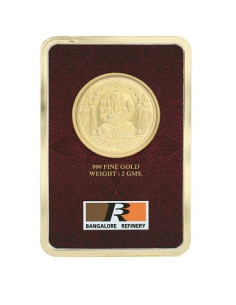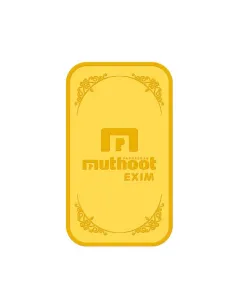Exclusive Deals & Trending Items
As the price of precious metals goes up and down, people are finding ways to save. They’re turning to eco-friendly gold recycling to help with the costs. You might be surprised to learn that gold recycling makes up a big 28% of all gold used, according to Metals Focus.
This method lets you get the most out of old, unwanted jewelry. It also helps the planet. By choosing precious metal recycling, you help save natural resources. And you reduce the harm caused by traditional mining.
Key Takeaways
- Gold recycling is a significant contributor to the total gold supply.
- Consumers can offset high prices by recycling old jewelry.
- Eco-friendly gold recycling promotes sustainability.
- Precious metal recycling conserves natural resources.
- Adopting gold recycling practices supports environmentally responsible habits.
The Rising Value of Gold in India
The value of gold in India is rising, influenced by both local and global economic factors. As a key player in the global gold market, India’s trends and prices affect many.
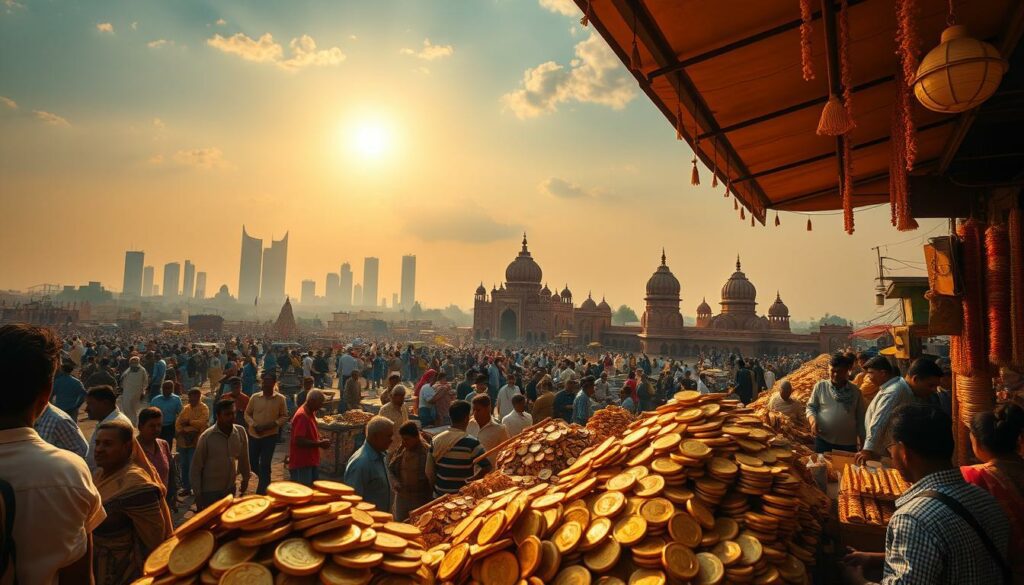

Current Gold Market Trends in the Indian Economy
The Indian economy is seeing a big change in gold market trends. Gold prices are going up because of inflation, currency changes, and global tensions. People in India buy gold not just for investment but also for cultural and traditional reasons like weddings and festivals.
Looking closer, we see that gold imports have gone up a lot, which is pushing gold prices higher. The government and financial groups in India help shape these trends with their policies and gold schemes.
| Year | Gold Price (INR/10g) | Gold Import (Tonnes) |
|---|---|---|
| 2022 | 50,000 | 600 |
| 2023 | 55,000 | 700 |
Why Gold Prices Continue to Climb
Gold prices keep going up because of global and local reasons. Global economic uncertainty and trade tensions make people want gold more as a safe asset. Also, the depreciation of the Indian rupee against the US dollar makes gold more expensive, pushing prices up.
The rise in gold prices also comes from growing demand in sectors like jewelry, investments, and technology. Knowing these reasons is key for those trying to understand the gold market.
Understanding Gold Recycling Fundamentals
Gold recycling is a green way to get gold instead of mining. It takes gold from old items like jewelry, coins, and electronic waste. This method saves natural resources and cuts down on mining’s harm to the environment.
What Is Gold Recycling?
Gold recycling collects and refines gold from old items. The gold recycling process includes steps like gathering, sorting, melting, and purifying. This makes the gold ready for use in jewelry and electronics.
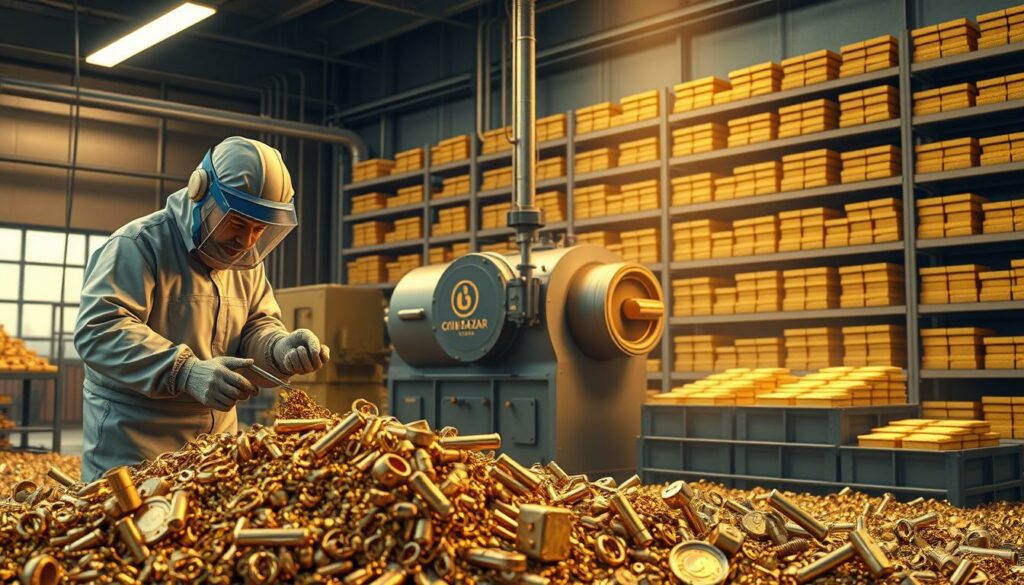

The Environmental Impact of Gold Mining vs. Recycling
Gold mining harms the environment a lot, causing deforestation, water pollution, and soil erosion. But, gold recycling is better for the planet. It cuts down on the need for new mining, which helps the environment.
By recycling gold, we lower the need for mining. This reduces the environmental damage from mining. As gold demand grows, recycling is key to meeting it without harming the planet.
The Economic Benefits of Recycling Your Gold Jewelry
Recycling gold jewelry is good for the planet and your wallet. As gold prices change, recycling your old jewelry can make you money.
In places like India, gold is more than just a metal. It’s a cultural treasure. Recycling your gold jewelry can save you money on new items.
How Recycling Offsets High Purchase Prices
When gold prices are high, new jewelry is pricey. But, recycling your old jewelry can help. You can melt it down and sell it, earning money for new items or savings.
For example, old gold ornaments can be worth a lot. Recycling them can give you cash. You can then buy new jewelry or invest it.
| Benefits of Recycling Gold Jewelry | Financial Impact |
|---|---|
| Offsetting High Purchase Prices | Reduces the cost of buying new gold jewelry |
| Creating Liquidity | Converts dormant assets into cash |
Creating Liquidity from Dormant Assets
Unused gold jewelry is like a hidden asset. Recycling it unlocks its value. This can be very helpful in emergencies or for big expenses.
“Recycling gold jewelry can provide financial liquidity, which can be a lifesaver during economic downturns or personal financial crises.”
Recycling gold jewelry is good for your wallet and the planet. It reduces the need for mining. When thinking about your old jewelry, remember recycling is a smart choice for your finances and the environment.
Types of Gold Items That Can Be Recycled
You can recycle many gold items, like jewelry and electronic waste. Gold recycling takes different forms of gold. This makes it easy to turn unwanted or broken gold into cash or new jewelry.
Jewelry and Traditional Indian Ornaments
Gold jewelry, including traditional Indian ornaments, can be recycled. Items like mangalsutra, bangles, and earrings, even if broken or outdated, have gold that can be reused. Recycling your old jewelry gets you a good price and gives your gold a new life.
Coins, Bars, and Bullion
Gold coins, bars, and bullion are also recyclable. These items, often made from high-purity gold, are widely accepted. If you have old or damaged gold coins or bars, you can sell them to gold buyers or refineries.
Electronic Waste Containing Gold
Electronic waste, like old phones and computers, has small amounts of gold. E-waste recycling is key, and recycling these items helps recover gold. It also helps reduce environmental pollution.
Some common gold items for recycling include:
- Broken or unwanted jewelry
- Gold coins and bars
- Electronic waste like old phones and computers
- Dental gold and other medical equipment
Evaluating Your Gold: What Determines Its Value
When you evaluate your gold, you need to look at its purity, weight, and how it was made. These things are key to figuring out what your gold is worth. This is true whether you want to recycle old jewelry or other gold items.
Understanding Gold Purity and Karats
Gold purity is measured in karats (kt), with 24kt being the purest gold. But, gold is often mixed with other metals to make it stronger and last longer.
Indian Gold Standards (BIS Hallmarking)
In India, the Bureau of Indian Standards (BIS) hallmarking is a mark of gold purity. It shows that the jewelry has been tested and meets certain purity standards.
International Purity Measurements
Worldwide, gold purity is measured in fineness, in parts per thousand. For example, 24kt gold is the same as 999.9 fineness.
Weight Measurement Standards
The weight of gold is also important in figuring out its value. In India, gold is weighed in grams or tolas. Internationally, it’s measured in troy ounces.
| Unit | Equivalent to |
|---|---|
| 1 Tola | 11.66 Grams |
| 1 Troy Ounce | 31.1 Grams |
How Craftsmanship Affects Recycling Value
The skill in making a gold item can really affect its recycling value. Pieces with detailed designs or historical importance might be worth more because of their beauty or cultural value.
Experts say, “The value of gold isn’t just in its purity and weight. It’s also in the art and skill that go into making unique pieces.”
“The art of jewelry making is not just about crafting beautiful pieces, but also about understanding the value of the materials used.”
Knowing these factors can help you make smart choices when recycling your gold items.
The Gold Recycling Process in Detail
The gold recycling process is complex and detailed. It turns unwanted gold items into valuable raw materials.
Collection and Sorting
The first step is collecting gold items. This includes old jewelry, coins, and more. These items are then sorted by their gold content, shown by their karat weight.
Sorting is key. It shows the purity and quality of the gold. Items with more gold are processed differently than those with less.
Melting and Refining
Next, the gold items are melted in a furnace at high temperatures. This melts the gold, creating gold bars or doré. These bars have a lot of gold but also other impurities.
The doré bars then go through refining. This process removes impurities to get pure gold. There are many ways to refine gold, like chemical and electrolytic methods.
Purification Methods
The final step is purification. The goal is to get gold as pure as possible.
Chemical Refining
Chemical refining uses chemicals to separate gold from other metals. The Miller process is one method. It uses chlorine gas to remove impurities.
Electrolytic Refining
Electrolytic refining uses an electrochemical process to purify gold. Gold is dissolved and then deposited at the cathode. This results in very pure gold.
The table below shows the main steps and methods in the gold recycling process:
| Process Step | Description | Methods Involved |
|---|---|---|
| Collection and Sorting | Collecting gold items and sorting them based on gold content | Manual sorting, karat testing |
| Melting | Melting gold items into bars or doré | Furnace melting |
| Refining | Removing impurities from gold | Chemical refining, electrolytic refining |
| Purification | Achieving high purity of gold | Chemical refining, electrolytic refining |
Where to Recycle Your Gold in India
In India, you can recycle gold in many ways. You can go to local jewelers or use government schemes. With gold prices going up, now is a great time to look into these options.
Reputable Jewelers and Gold Buyers
Many reputable jewelers in India offer gold recycling services. Brands like Tanishq and Malabar Gold have programs for buying back old gold. It’s important to find trusted jewelers in your area for a fair deal.
- Check for jewelers with good market reputation
- Verify their gold assessment methods
- Compare offers from multiple jewelers
Banks That Accept Gold
Some banks in India now accept gold. State Bank of India and HDFC Bank offer gold-related services. They might not buy gold directly, but they can help with government schemes or other gold products.
Government Gold Monetization Schemes
The Indian government has launched schemes to promote gold recycling. Two key initiatives are:
Sovereign Gold Bond Scheme
This scheme lets you invest in gold through bonds. It’s a tax-efficient way to invest in gold.
Gold Monetization Scheme
With this scheme, you can deposit your gold in a bank. It will be used for jewelry making and other industrial uses. You earn interest on your deposited gold.
How to Prepare Your Gold Items for Recycling
To get the most value from recycling your gold, preparation is essential. A few simple steps can make a big difference in what you get.
Cleaning and Sorting Your Gold
Begin by cleaning your gold items carefully to remove dirt. Use a soft cloth and a mild soap solution. Stay away from harsh chemicals that could harm the gold. After cleaning, sort your items by their gold content, like 14k, 18k, or 24k.
Sorting helps recyclers understand the value better. For example, separate jewelry with gemstones from plain gold items. This is because gemstones can change how the recycling process works.
Documenting Your Items
It’s important to document your gold items to prove their authenticity and value. This can help you get a better price.
Photographing Your Jewelry
Take clear, well-lit photos of your gold items from different angles. This visual record helps show the item’s condition and authenticity.
Maintaining Purchase Records
Keep all receipts, certificates of authenticity, or any other documents related to your gold items. These records can greatly increase the credibility of your gold’s value.
| Preparation Step | Importance | Tips |
|---|---|---|
| Cleaning | Removes dirt, enhancing value assessment | Use mild soap and a soft cloth |
| Sorting | Facilitates accurate gold content assessment | Sort by karat and type (jewelry, coins, etc.) |
| Documenting | Proves authenticity and value | Keep receipts and certificates; take clear photos |
Getting the Best Price for Your Recycled Gold
To get the best price for your recycled gold, knowing what affects its value is key. The price you get can greatly impact your earnings from recycling. Being informed and strategic can help you earn more.
Understanding the gold market dynamics is crucial. Gold prices can change, affecting your earnings. Keeping up with market trends helps you make better choices.
Timing the Market
Timing is everything when selling recycled gold. Monitoring gold price trends and knowing what affects them can help. Economic stability, inflation, and world events have all played a role in gold prices.
Negotiation Strategies in the Indian Market
Negotiation is key to getting a good price for your gold. Knowing the market price and your gold’s details helps you negotiate better. In India, building trust with buyers and being open can lead to better deals.
Comparing Offers from Multiple Buyers
It’s wise to compare offers from different buyers. Contact jewelers, gold buyers, and banks for quotes. Evaluating these offers based on price, service, and reliability is important. The highest offer isn’t always the best if the buyer is not trustworthy.
The Gold Exchange Process: What to Expect
Understanding the gold exchange process is key for a smooth transaction. When you choose to exchange your gold, several steps are involved. These include initial documentation, testing, and valuation.
Documentation Requirements in India
In India, you need certain documents to exchange gold. These include your identity proof and sometimes proof of purchase. Having these documents ready can speed up the process. Always check with the institution or jeweler to know what you need.
Testing Procedures
The value of your gold is found through testing. These tests check the gold’s purity and weight. Both are important for determining its value.
XRF Testing
XRF (X-ray Fluorescence) testing is a non-destructive way to check gold. It gives an accurate purity reading without harming the item.
Acid Testing
Acid testing uses acid to see how the gold reacts. This shows its purity.
“This method, while effective, requires careful handling to avoid damage to the gold item.”
Common Scams to Avoid in Gold Recycling
The gold recycling industry is growing fast, but so are scams. It’s key to know about the scams that can happen when recycling gold. Knowing about these scams helps protect you from bad practices.
Weight Manipulation Tactics
One scam is changing the weight of your gold. Scammers might use fake scales or tricks to make less gold. To stay safe, make sure the weight check is open and clear. You might even want to bring your own scale.
Tip: Ask the dealer to show their scale works right with a known weight.
Purity Testing Fraud
Testing gold purity is important to know its value. But, some bad dealers might lie about the gold’s purity to pay you less. Watch out for dealers who don’t clearly explain how they test purity.
- Make sure the testing method is clear and easy to understand.
- Ask for proof of the purity test results.
Protecting Yourself from Unethical Dealers
It’s important to work with honest gold buyers. Look up potential buyers and read reviews or complaints. Also, knowing the current gold market price can help you get a better deal.
| Scam Type | Description | Prevention Tip |
|---|---|---|
| Weight Manipulation | Tampering with scales to reduce gold weight | Verify scale accuracy |
| Purity Testing Fraud | Misrepresenting gold purity | Understand and verify testing methods |
| Unethical Dealers | Unfair practices by dealers | Research dealers and understand market prices |
Gold Recycling: A Sustainable Alternative to Mining
Sustainable gold recycling is changing how we get, process, and use gold. It cuts down the need for new mining. This move not only lessens environmental harm but also saves natural resources.
Evolution of Gold Recycling in India
Gold recycling in India has grown a lot over time. It’s driven by economic and environmental reasons. More recycling facilities and better technology have appeared.
Reports show that new tech has made recycling gold more practical.
Technology Advancements in Gold Recovery
New tech in gold recovery has made recycling better. Modern refining methods lead to purer gold and less waste. Experts say, “New tech in recycling has boosted recovery rates and cut down on pollution.”
These improvements are key in making recycling a green choice over mining. They help meet global goals to lessen the gold industry’s environmental impact.
Tax Implications of Selling Old Gold in India
Thinking about selling your old gold in India? It’s key to know about the taxes involved to get the most from your sale. There are several tax factors to consider that can affect your profit.
Capital Gains Considerations
The profit from selling gold is taxed as capital gains. The tax rate varies based on how long you’ve owned the gold. If it’s less than 36 months, it’s short-term and taxed based on your income tax slab.
For gold held over 36 months, it’s long-term capital gain. This is taxed at a flat 20% rate with indexation benefits.
- Short-term capital gains: Taxed as per your income tax slab.
- Long-term capital gains: 20% tax rate with indexation benefits.
Documentation for Tax Compliance
Having the right documents is crucial for tax compliance when selling gold. You’ll need to provide specific documents to the buyer or authorities.
PAN Card Requirements
A PAN card is required for gold sales over a certain amount. Make sure you have your PAN card details ready.
GST Implications
Goods and Services Tax (GST) might apply to the making charges or value added during gold sales. But, the sale of old gold itself isn’t taxed by GST if it’s a second-hand sale. Knowing these details can help you better understand the tax side of things.
It’s wise to talk to a tax expert to ensure you’re following all tax rules and getting the most tax benefits.
Cultural Significance of Gold Recycling in Indian Traditions
Gold recycling is a big part of Indian traditions. It shows the metal’s deep cultural and emotional value. In India, gold stands for wealth, luck, and family history.
Family Heirlooms and Generational Transfers
Gold jewelry is a treasure passed down in families. It carries sentimental value and emotional weight. Recycling these pieces keeps family history alive and makes the gold meaningful for the next generation.
Wedding Jewelry Transformations
Indian wedding jewelry is famous for its detailed designs and cultural importance. Recycling old wedding jewelry into new pieces is common. It lets brides wear modern styles that still respect traditional craftsmanship.
| Aspect | Traditional Significance | Modern Relevance |
|---|---|---|
| Family Heirlooms | Passed down through generations | Recycled into modern designs |
| Wedding Jewelry | Cultural and symbolic significance | Transformed into contemporary styles |
Gold recycling in India is more than just saving a resource. It keeps cultural traditions alive by mixing the old with the new.
Transforming Old Gold into New Designs
Renewing your old gold is simpler than you might think. Many Indian jewelers provide exchange programs and custom redesign services. This lets you turn outdated gold jewelry into modern, trendy pieces that match your style.
Exchange programs let you swap your old gold for new designs. You might even get discounts or loyalty rewards. This makes it easy to update your gold collection with Indian jewelers.
Exchange Programs at Indian Jewelers
Indian jewelers’ exchange programs are designed to simplify transforming old gold into new pieces. Here’s how it works:
| Program Feature | Description | Benefit |
|---|---|---|
| Gold Exchange | Exchange old gold for new jewelry | Get the latest designs |
| Loyalty Rewards | Earn points for every exchange | Redeem points for discounts or free services |
| Assessment | Professional assessment of gold value | Ensure fair value for your old gold |
Custom Redesign Options
For a more personal touch, consider custom redesign services. Many Indian jewelers offer bespoke design services. They work with you to create a unique piece from your old gold.
Choosing custom redesign means your new piece will be stylish and meaningful. It’s made from your existing gold, adding sentimental value.
Conclusion: Making Informed Decisions About Your Gold Assets
You now know about the gold recycling process and its benefits. It’s good for the economy and the environment. You can make smart choices about your gold by understanding how to recycle it.
Recycling your gold jewelry or items can lower costs and turn old assets into cash. In India, you have many options like jewelers, banks, and government schemes. This lets you pick the best way to handle your gold.
By choosing wisely, you can get the most out of your gold. This also helps the gold industry become more sustainable. Start managing your gold today and see what opportunities you can find.






